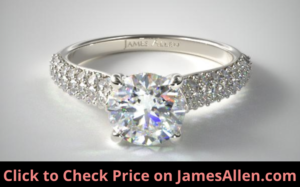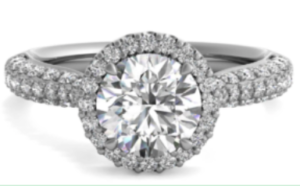
It’s natural to focus on finding the right diamond for your ring, but don’t neglect the impact a setting has on its overall performance.
Pavé and micro pavé are two designs with diamonds along the shank.
The main difference between them is pavé settings include diamonds of any size that line the ring, while micro pavé features several small gems that are uniform in size and often less than 0.01 carats. They give the illusion the ring is made of diamonds.
We’ll compare pavé vs micro pavé settings for diamond rings, including:
- An overview of each style
- Three differences
- What they have in common
- How to decide which is right for you
What are Pavé Settings?
Pavé settings enhance the brilliance and fire of an engagement ring through tiny diamonds set along the band. They sit between metal prongs or on top of beads, creating a single line of diamonds cascading each direction from the main gem.
It’s pronounced “pa-vay.” The French word means “to pavé,” which is referring to how the ring is pavéd with diamonds.
With a pavé setting, you have an alternative to the classic solitaire design without adding significant cost or distracting from the center diamond. In fact, it’s one of the most popular ways to enhance an engagement ring.
Take this pavé setting as an example, from where I bought my wife’s engagement ring.
Check out the image on their website, because you can rotate the high-resolution image 360 degrees to learn how it appears at every angle.
The colorless diamonds lining half the shank complement the 18K white gold setting and eye-clean diamond on top. When you twirl the ring, it will glimmer in every direction.
What are Micro Pavé Settings?
Micro pavé settings feature small diamonds that run down both sides of the ring. They’re held in place by miniature metal prongs, which are often invisible unless you’re examining the ring in detail.
Their purpose is similar to traditional prong settings. The gems add sparkle to the piece so it isn’t all consolidated in one place.
In fact, one of its benefits is it causes the main diamond to appear more brilliant because of how light reflects from the micro pavé diamonds to the larger gem.
If you’ve chosen an engagement ring diamond that’s less than one carat or that doesn’t have an excellent cut, you can improve its performance with a micro pavé setting.
Here’s a micro pavé setting with a total carat weight (CTTW) of 0.09.
There are 22 eye-clean diamonds on the ring that appear colorless.
It’s a subtle design that doesn’t overshadow the center diamond but instead amplifies its overall appeal.
How are Pavé and Micro Pavé Different?
1. Size of Diamonds
The size of pavé diamonds is the distinguishing factor between pavé and micro pavé. To the naked eye, the difference might not be apparent, but their carat weights are a giveaway.
As an example, check out this platinum pavé setting.
It includes 16 round-cut gems, with eight falling down each side of the center diamond.
Because the CTTW is 0.25, we know each one weighs about 0.015 carats.
This exceeds the limit typically designated for micro pavé, which is 0.01.
On the other hand, the diamonds in this engagement ring weigh about 0.004 carats each.
So it’s classified as micro pavé.
For this reason, you’ll often find a higher number of diamonds in this type of pavé compared to pavé. The typical number for a pavé setting is eight to 12, and for micro pavé, it’s often more than 20.
2. Design Options
Jewelers can create more designs using micro pavé diamonds compared to pavé.
The reason is micro pavé gems are so small. When the band can hold up to 100 diamonds, there are an endless number of ways to place them.
This triple row pavé engagement ring provides an example.
There are three rows on the ring containing a total of 58 diamonds. Because the CTTW is 0.50, each micro pavé diamond is less than 0.01 carats.
But pavé settings are available with multiple stone sizes. They don’t have to be uniform like a micro pavé setting. They could weigh 0.015 carats or heavier.
In rare cases, you might even find a pavé setting with gems that aren’t round cuts. It may feature oval cuts.
If you’re searching for pavé or micro pavé settings in a jewelry store, you’ll likely find more options available for the former.
They’re a more popular choice because of the simplistic design and affordability it offers, without adding potentially dozens of new diamonds.
3. Brilliance
Pavé settings display more brilliance because the diamonds are larger. If all else is equal, heavier diamonds have strong light performance because of their wider surface area to collect and reflect light.
When they have quality cuts, pavé diamonds are effective in enhancing the fire and brilliance of your ring.
This scalloped pavé design has 0.43 carats of round cuts.
Because there are only 14 gems, each is larger than what you’d find in a micro pavé setting. Combined with an excellent-cut diamond on top, you can expect exceptional sparkle from the entire piece.
This doesn’t mean micro pavé doesn’t improve brilliance. But its continuous row of tiny diamonds won’t match the glimmer provided by larger diamonds extending the same length down the ring.
Both are a fitting choice if you’ve chosen a step-cut diamond such as an emerald or Asscher cut. Those don’t display the high degree of brilliance you’ll find from princess, round, and marquise cuts.
So the diamonds along the ring help compensate for that shortcoming.
What Do They Have in Common?
Pair with Other Styles of Settings
They aren’t limited to small diamonds on the shank. They’re often paired with other styles like halos or three-stone designs.
This three row pavé engagement ring includes a halo of diamonds circling the main one.
The uniform aesthetic between the pavé diamonds and halo are a perfect complement to each other and the diamond on top.
This 14K yellow gold ring mimics that style as well.
Affordability
Another common trait between the two settings is they’re more affordable than increasing the weight of the center diamond.
The price of a diamond doesn’t rise linearly, which you’ll notice if you compare the price of a one versus two carat diamond. Instead, the price increases exponentially.
For example, you’ll pay more than twice as much for a one-carat diamond than a 0.50 carat gem.
So it’s generally less expensive to add pavé or micro pavé diamonds with a CTTW of 0.25 than it is to upgrade your center diamond to one that’s 0.25 carats heavier.
When it comes to micro pavé and pavé prices, they’re often similar.
The pavé setting below has a CTTW of 0.29 and costs $1,590.
This micro pavé setting has a CTTW of 0.20 and costs $1,340.
The reason the prices are similar is because although the larger diamonds on pavé settings are more valuable, the process of creating a micro pavé setting is tedious and detailed, which adds to the cost.
How to Decide Between Pavé and Micro Pavé
If you’re comparing pavé versus micro pavé, you’re deciding between settings that are in the same category.
So here are some guidelines to help you learn which is right for you.
Consider pavé settings if:
- You’re interested in a simplistic design that offers an alternative to a solitaire
- You don’t want to deal with any maintenance or cleaning issues resulting from so many small diamonds on your ring
- You want to improve the light performance of a piece that may not have a large center diamond
You should opt for a micro pavé setting if:
- You appreciate the aesthetic of a continuous row of diamonds on the ring
- The idea of adding multiple rows of micro pavé gems is appealing
- Increasing the weight of the center diamond would result in too high of a price, but you want to add to the ring’s CTTW
By understanding the differences between pavé, micro pavé, you’ll create a stunning diamond ring that will last a lifetime.

Jacob Clarke
Jacob Clarke is the founder of TeachJewelry.com.
He earned an Applied Jewelry Professional Diploma from the Gemological Institute of America (GIA) and now brings you essential information about diamonds, settings, and more.
Jacob has consulted with leading jewelry brands, and his work has been cited in Clean Origin, Diamond Nexus and industry publications.
He's also a member of the International Gem Society.
He enjoys discussing jewelry with readers, so contact him with any questions at jacob.clarke@teachjewelry.com.





















